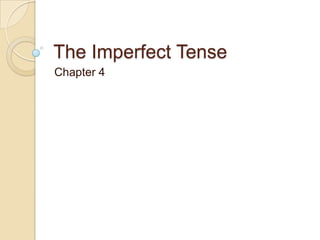Report
Share

Recommended
More Related Content
What's hot (16)
Unit 17 relating sentences- negatives, questions, passive and active

Unit 17 relating sentences- negatives, questions, passive and active
Similar to Chapter 4 The Imperfect Tense
Similar to Chapter 4 The Imperfect Tense (20)
More from spreaves
More from spreaves (20)
Chapter 4 The Imperfect Tense
- 1. The Imperfect Tense Chapter 4
- 2. Formation of the Imperfect There is a simple formula to remember when forming the imperfect: present stem + “ba” + personal endings
- 3. Exception! The personal endings are ALMOST identical to the ones that you used with the present tense. They are: -m* -mus -s -tis -t -nt *In the present tense, 1st person, singular ending was an –o.
- 4. Examples Step 1: Find the present stem by taking the –re off the infinitive. amo, amare, amavi Present stem= ama
- 5. Step 2 Add “ba” to the present stem:
- 6. Step 3: Add the personal endings.
- 7. 3rd –io verbs and 4th Please note that verbs whose first principal parts end in –iowill have an “ie” before the “ba.” Example: audio, audire, audivi
- 8. Translation The imperfect tense is used for incomplete action in the past. Translate it with “was,” “were,” or “used to.” “Amabat” could be translated as “he was loving” or “he used to love.”
- 9. Imperfect of “to be.” Because the verb “to be” is irregular, you will have to memorize the imperfect forms just as you did for the present. Notice that the endings are still the same, though!
- 10. Imperfect of “to be.” eram - I was eramus- we were eras - you were eratis- you were erat - he was erant- they were